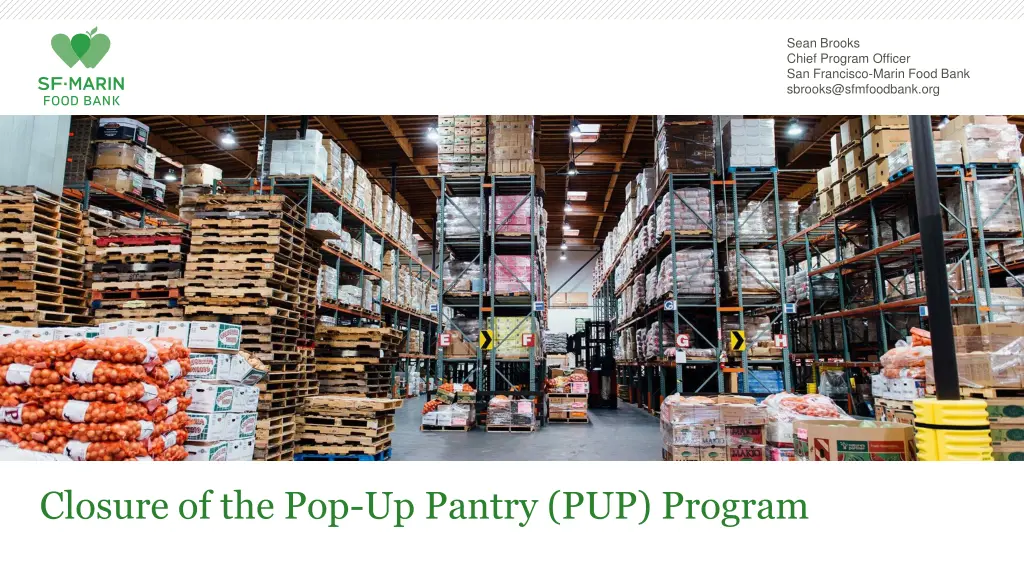
Pop-Up Pantry Program Closure and Final Stats in San Francisco
Learn about the closure of the Pop-Up Pantry Program by San Francisco-Marin Food Bank, its history, overview, statistics, and final details. The program, which served over 22,000 participants per week at its peak, is set to close in June 2025 due to financial challenges. Discover how participants are being transitioned to other food bank services and the current status of active households and waitlisted individuals in different neighborhoods.
Download Presentation

Please find below an Image/Link to download the presentation.
The content on the website is provided AS IS for your information and personal use only. It may not be sold, licensed, or shared on other websites without obtaining consent from the author. If you encounter any issues during the download, it is possible that the publisher has removed the file from their server.
You are allowed to download the files provided on this website for personal or commercial use, subject to the condition that they are used lawfully. All files are the property of their respective owners.
The content on the website is provided AS IS for your information and personal use only. It may not be sold, licensed, or shared on other websites without obtaining consent from the author.
E N D
Presentation Transcript
Sean Brooks Chief Program Officer San Francisco-Marin Food Bank sbrooks@sfmfoodbank.org Closure of the Pop-Up Pantry (PUP) Program
Pop-Up Pantry (PUP) Program History Many Food Bank partner pantries closed early in the Covid pandemic. The Food Bank partnered with SF County disaster workers and community volunteers to start mass grocery distributions in outdoor public settings, distributing produce and surplus federal food to all in need. The program was funded by a mix of County, federal, and private support. At the peak, there were 22 locations serving 22,000 participants per week, with some sites serving 1300+ in 4-hrs. sfmfoodbank.org | page 2
Pop-Up Pantry Overview Participants were all enrolled in the Food Bank database. Timeslots were assigned to shorten lines. Households were deduplicated across the Food Bank network. Converted from pre-bagged to farmers market-style distribution with choice. Standard menu featuring seasonal produce, a protein and a grain. sfmfoodbank.org | page 3
Pop-Up Pantry Stats Began closing the program after losing significant financial support. Last distributions will be this Friday, June 6, 2025. FY23 FY24 FY25 Active Households (Yr-end) Units of Service (Total) Pounds of Food (Total) 17,500 10,500 7,250 864,332 609,123 415,680 19,904,254 15,425,229 11,865,928 sfmfoodbank.org | page 4
Pop-Up Pantry Closure Initially notified participants of the June 2025 closure late 2023, closed enrollment. Started actively transferring and waitlisting participants at Food Bank partner pantries and community markets in late 2024. Transferred over 2,600 participants to available capacity since November 2024. There is limited space still available in some areas. To-date over 80% of the remaining approximately 7,000 participants have been added to partner pantry waitlists. Wait times for many will be long. sfmfoodbank.org | page 5
Final Stats Neighborhood North Beach Sunset Western Addition Western Addition Tenderloin SOMA Ingleside Sunset/Lake Merced Stonestown (Wed) Sunset/Lake Merced Stonestown (Fri) Portola Bayview Visitation Valley Location 750 Greenwich St. 2050 41st Ave. Glad Tidings St. Dominic's Golden Gate Greenway 7750 Lapu Lapu St. City College District D3 D4 D5 D5 D5 D6 D7 D7 D7 D9 D10 D10 Active Participants On Waitlist 1038 818 1003 35 189 53 173 718 544 588 533 342 684 5830 1117 103 237 121 356 808 660 668 652 447 825 7249 100 Somerset St. Cornerstone Missionary Baptist Cow Palace sfmfoodbank.org | page 6
Reflections You re never ready for a disaster. Grocery distribution is very scalable. It takes & makes a village to respond to a disaster. The Food Bank is a community resource coordination and collaboration is strength. Continue to take advantage of opportunities (tariffs create surplus food). Demand never returns to baseline. Donated produce is cheap, healthy and (mostly) cross-cultural. Food Bank is exploring cultural menu customization, but expensive & complicated to coordinate in diverse community. sfmfoodbank.org | page 7
Next Steps Food Bank is investing in Community Markets & equitable-access. Continue conversations about better public and nonprofit collaboration and coordination. Advocate for public support for nonprofit food distribution capacity growth to shorten waitlists. Advocate for public investment to improve/bolster CalFresh access given likely dramatic cuts to SNAP/CalFresh. sfmfoodbank.org | page 8
APPENDIX Current Demographics






















